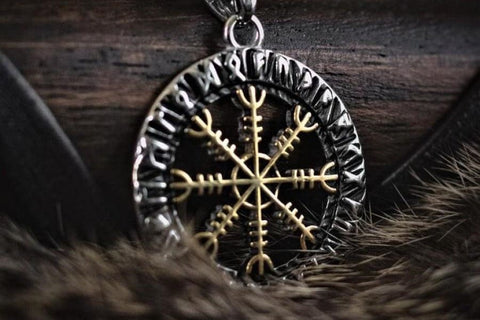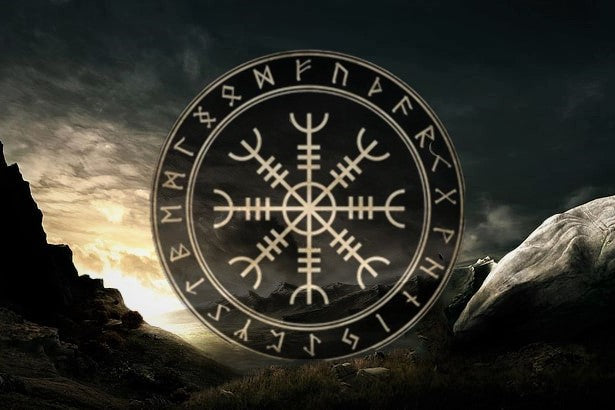The Secret Meaning Behind Aegishjalmur, The Helm Of Awe
Aegishjalmur is an ancient symbol that does not have a definite translation. It means protection and serenity, among other things so you know it's gonna come in handy.
You're probably wondering, "What is aegishjalmur"? Why is it called the "Helm of Awe"? And what does that mean? Well, it means you need to read this article. When traveling through Jotunheim — also known as home to the giants in Norse Mythology — Thor met a giant who had an enormous and terrifyingly beautiful head. But wouldn't you assume such a large head might create problems?
The Viking Aegishjalmur is an ancient symbol. It was created to be worn by someone with great valor who all fear, and inspires awe in all those who look upon him. The meaning of the symbol has been passed down through history until this day.

In the Galdrabók, one of the representations of the Ægishjálmr
What does the Helm of Awe represent?
Aegishjalmur is a symbol of the Viking culture and is most commonly used as a symbol for Protection. The symbol looks like a Helm or a Crest and is the name given to Norse mythology’s version of Thor’s hammer: Mjollnir.
The Aegishjalmur (or “Helm Of Awe”) is typically worn as a pendant, or on a necklace. It can also be worn in the form of temporary tattoos. Most commonly, it is worn as part of the Asatru religion that incorporates Norse mythology into its beliefs.
Aegishjalmur has been around since at least 1000 AD. There are several accounts of where it came from, but the one that seems most believable to me is that it was drawn by an Icelandic priest who lived in the 11th century AD. He drew it in order to represent Thor’s hammer, Mjöllnir (which itself represents Thor himself). The symbol was most likely created for protection—in Viking society, warriors wore it on their bodies as a way to protect themselves against evil spirits, curses, and bad luck.
What is the Helm of Awe? The earliest mention of the Helm of Awe (aka Aegishjalmur) is from a runic inscription on a Viking stone monument in England, dating back to somewhere between 958-1020 CE. The inscription translates to "Aegyshjalmr is [this] helmet's name; repels one [i.e., Hel] and all harm."
Texts from the following centuries tell tales of both the Helm of Awe as well as Odin himself using it to protect his people. There are also accounts of Thor, who was said to use a similar symbol, using his own version of the Helm.
The two main theories on its origin are that either the Vikings or their ancestors encountered an actual Helm while raiding in Ireland and brought it back with them, or that the image was inspired by a misinterpretation of a Christian symbol, such as Christ's halo.
The name Aegishjalmur translates to 'helm of awe' and is a famous symbol worn in Norse mythology. The 'helm' refers to the shape of the symbol, which can be made using two hands. If you extend your arms out, palms down, and place one hand on top of the other, this is the basic shape.
This symbol was commonly used as a protective charm against magic and in Norse poetry, it is often referred to as a protection for warriors.
 Aegishjalmur Helm Of Awe Runic Necklace
Aegishjalmur Helm Of Awe Runic Necklace
The meaning behind this symbol is explained in the poem Haustlöng, written by the Icelandic poetess, EilífrGoðrúnarson. This poem was recited at weddings, feasts, and anywhere else where people wanted to be protected from evil magic or against being surprised by an enemy.
In Haustlöng, the valkyrieÞóru explains to her son Sinfjötli that if he sees a symbol of two hands on someone's door or piece of clothing, he must draw it on his own body so that he will be protected from danger. This shows how confident people were in the power of this rune and also suggests that they often wore it on their bodies.
When we think of a Viking's helmet, a few things come to mind: the fierce battle face it must have created, the horned shape that might have inspired images of the devil for later cultures, and its practical traits as protection from weapons. But there might be another reason why Vikings wore helmets into battle—and that is to ward off the powers of their enemies. This strange magical symbol, called Aegishjalmur (or "Helm of awe"), was believed to give the wearer power over the enemy in the same way that it would strike fear into their hearts and make them lose courage. The image on top is just one representation of this symbol, which you can see in other shapes as well. It makes sense that Viking helmets would include such powerful and meaningful symbols—after all, they didn't have written language or books during their time, so they relied on symbols to tell stories and communicate important ideas.
You've likely seen the symbol of a Viking helmet called an aegishjalmur, worn around the neck or pinned onto clothing, but what does it mean? The word translates to "helm of awe," which historically meant that whoever wore the necklace (and therefore bore its symbol) was famous and powerful enough to instill fear. It's said that the aegishjalmur was also used to ward off evil spirits and protect against nightmares. It's easy to see how this symbol might have been used for both of these purposes—it's a fierce-looking piece of jewelry, with horns protruding from either side, and it's large and heavy enough to be worn as jewelry. The ancient Vikings would have been proud to wear this symbol, and they would have been able to display it proudly without anyone knowing its meaning beyond their culture. Today, however, we are more familiar with Norse mythology than most people in the past were. This means that we can enjoy the beautiful design behind this symbol while also understanding why it might have been so popular hundreds of years ago.
Helm Of Awe Aegishjalmr Wooden Watch
Is The Helm Of Awe Real? The Truth Revealed
For many years now, the world has been wondering about a very important question: is the helm of awe real?
The true purpose of the helm of awe is unknown, but many people believe that it was created by an ancient civilization to protect humanity from the flood.
For years, the idea of a helmet that can make you fly has been a staple of science fiction and fantasy. Though it's often used as a mode of transportation, it's also been known to protect the wearer from harm, or even give the power to see into another dimension. The "Helm of Awe" (also known as the "Helmet of Awe" or "Helmet of Terror") is a kind of magical object that you've probably seen in any number of fantasy stories—and though this type of object isn't exclusive to fantasy, it's always found in those genres.
What does this mean? Is there really such a thing as a magic helmet? Is it more than just an inspiration for fiction?
It depends on who you ask. There are many people who believe in these types of objects and the power they wield... but there are also plenty who don't.
When you think about the Helm of Awe, what's the first thing that comes to mind? Is it the symbol of the Norse god Odin adorning the heads of his warriors, or a beacon of light in a dark and dangerous world? Or maybe it's a fictional relic from J.R.R Tolkien's The Lord of the Rings, a magical object that makes its wearer more powerful by helping him focus his thoughts. But as much as we may want any of those definitions to be true, science tells us they're not quite right.
"The Helm of Awe" is actually defined as "a condition in which the feelings of an individual experience associated with awe (e.g., feelings of helplessness, insignificance, and temporal loss) while perceiving the vastness of nature." So, if you've ever felt like you were standing at the edge of a waterfall and were so awestruck by how enormous it was that you were rendered speechless—that was probably it.
Understanding the Helm's origin requires a little bit of context: "Titan Quest" takes place in ancient Greece, at a time when humans were still trying to figure out things like agriculture and metalworking. In this world, you play as either a warrior or a mage, each with their own strengths and weaknesses, and you battle your way through different areas filled with monsters, traps, treasure chests, shrines to gods for you to pray at for powerups and more.
The warriors are especially good at taking on multiple enemies at once—they can hold their own in the thick of combat, and they have plenty of moves that do damage over time. The mages' powers are usually more focused on one target at a time. While they're able to unleash impressive single attacks, they're less equipped for standing up to a swarm of enemies all attacking them simultaneously.
It's the question that has plagued mankind since the dawn of time (or since at least the dawn of the internet): is The Helm of Awe real?
Well, we here have devoted our lives to getting to the bottom of this mystery. We've scoured every corner of the internet, read all of the books, and interviewed every expert on this subject. And we finally have an answer for you: yes, it's real…
…but not in the way you think.
Aegishjalmur is one of the oldest symbols from Norse mythology. It has at least three separate meanings, more if you create stories to support every combination possible. Traditionally, it's about being safe as long as you are wearing it. I believe this is an interpretation unique to warriors since they were the only ones allowed to wear helmets (including horns) when in battle.
Aegishjalmur is a mystical symbol that can be found depicted on various different Viking helms and shields. Not much is known about its history, but the majority of historians believe that its presence in these articles is indicative of Viking religious beliefs. Here's a closer look at what this symbol meant to the Vikings, and why it was included in pieces of weaponry.
While this is probably not the conclusion most people would reach looking at an image of the Aegishjalmur, I can assure you it is a true one. If you find yourself bemused or perhaps even angry, take a moment to imagine yourself in the position of the ancients who first conceived of the symbol by watching the sky. We owe it to them to think about what they might have meant when they created it. It’s a shame we can’t travel back in time and ask them directly.
Hopefully, after reading this article you've learned a new and extremely valuable piece of information. Now you know what the secrets are to creating good logos and how they work. In any case, remember to pay close attention in your ventures, because you never know, the next time you need a logo that someone might ask you, "would it be all right if I put an Aegishjalmur on my logo?"





i have a pendant of a raven skull made from copper that has this symbol on its forehead. It really speaks to me. some connection from deep within. Like a cactus somewhat similar in terminology.
I would like more issues or merchandise with this symbol.I got a helm of Awe at Iceland
Today I was in the place of awe of nature for some hours. Two black ravens came. Tonight I studied Viking symbols, sketching them I have awoken from a dream just now in which I was able to control my direction in the dream with the other identity taking me where I didn’t wish.
The helm of awe IS like a snowflake design, the place of wonder. You are correct. When in awe of creation you resonate with the master programmer. In this you steer your Viking ship in your life, no longer controlled by others or enemies. You have full wisdom and objective thought… to change your life direction as new information comes to hand. This means, you have no fear in battle you are active in all realms and think as one with Odin!
Thank you so much for an amazing read. I have the Aegishjalmur (Helm of Awe) tattooed on my back and i wear a pendent of it as well. I’m in the South African Police and have been for 32 years now. I believe it has kept me safe.
Laissez un commentaire